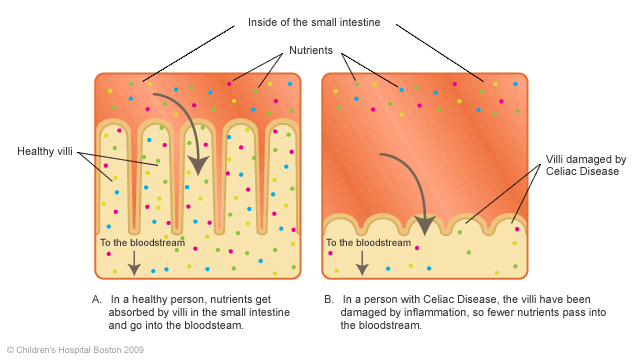 Celiac disease (also known as coeliac disease or celiac sprue) is the name of a condition in which the body’s own immune system reacts to gluten, a protein found in many common foods such as cereal, bread, and pasta.
Celiac disease (also known as coeliac disease or celiac sprue) is the name of a condition in which the body’s own immune system reacts to gluten, a protein found in many common foods such as cereal, bread, and pasta.
How does celiac disease affect the body?
Over time, this immune reaction to gluten damages the small intestine, where most nutrients are absorbed into the body. Eventually the body becomes malnourished no matter how much food is eaten, because the body can no longer absorb enough of the nutrients in the food.

What are the symptoms of celiac disease?
The symptoms of celiac disease can vary widely from person to person. The disease can affect the digestive system as well as other seemingly unrelated body systems. The most common gastrointestinal (digestive) symptoms of celiac disease are weight loss and diarrhea, but can also include:
- Abdominal bloating
- Abdominal pain
- Constipation
- Unusual stool (Specifically pale, greasy bowel movements)
- Vomiting
Other symptoms include:
- Fatigue
- Headaches
- Bone or joint pain
- Iron-deficiency anemia (low blood cell count due to low iron)
- Loss of bone density (Osteoporosis)
- Depression and anxiety
- Canker sores in the mouth
- Tingling and numbness in hands and feet
- Dermatitis herpetiformis – A specific type of intensely itchy skin rash
Younger people suffering from celiac disease during years of growth may experience:
- Delayed growth and stature
- Delayed puberty
- Dental problems including defects of the enamel (the hard, white visible part of the tooth)
How common is celiac disease?
Celiac disease occurs in roughly 1 in 133 people. It’s considered a genetic disease; although not everyone with the genes gets celiac disease. The triggers for developing celiac disease are not known at this time but certain environmental factors, such as a viral infection, may trigger the disease in someone who already carries the genes.
How is celiac disease diagnosed?
Celiac disease can be difficult to diagnose because the symptoms are often similar to the symptoms of other diseases. Several tools do exist to help with diagnosis however, and they include:
Blood tests: Since celiac disease is an immune response to gluten, a health care provider will order blood tests.
Directly viewing the small intestine: Since celiac disease results in inflammation and destruction of the lining of the small intestine, a health care provider may order an endoscopy, a test in which a skinny flexible instrument called an endoscope is inserted through the mouth all the way down to the small intestine. A biopsy may be taken, where a small sliver of tissue is removed with the endoscope to be viewed in more detail.
How is celiac disease treated?
Since the symptoms of celiac disease are caused by a reaction to gluten, the main treatment for the disease is to strictly avoid eating foods that contain gluten. Complete elimination of gluten from the diet generally allows the small intestine to heal and enables the body to properly absorb the nutrients from food. This “gluten-free diet” must be maintained for the patient’s lifetime – a return to eating gluten means new damage to the small intestine and a return of symptoms.
Source: Read Full Article



